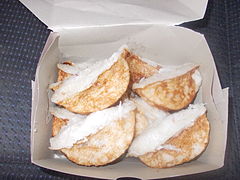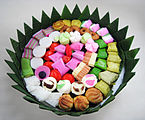Kue pancong
 Freshly baked kue pancong. | |
| Alternative names | Kue pancung, bandros, gandos |
|---|---|
| Type | Baked sweet coconut cake |
| Course | Snack |
| Place of origin | Indonesia |
| Region or state | West Java, Jakarta, Makassar |
| Serving temperature | Warm or room temperature |
| Main ingredients | Rice flour, eggs, coconut milk, grated coconut, sugar |
| Similar dishes | kue pukis, kue rangi |
Kue pancong is an Indonesian kue or traditional snack made of a rice flour and coconut-based batter and cooked in a special mold pan. It is a commonly found snack in Indonesian traditional markets. The mold pan is similar to a muffin tin but has rectangular basins instead of rounded. It consists of a row of rectangular basins of small tubs with rounded half-moon bottoms, to create half-moon or boat-shaped hot cakes. A pancong mold is quite similar to a waffle mold. The special grill-like metal mold used in making kue pancong is also used in other Indonesian traditional kue, including kue pukis and kue rangi, and so the shape is quite similar to those cakes. Kue pancong is often regarded as the coconut version of wheat-based kue pukis.
Name
[edit]The term kue pancong is usually associated with the Betawi cuisine of Jakarta.[1] The same snack (with some variation) is also referred to as kue pancung in parts of central Sumatra,[2] gunjing in South Sumatra,[3] bandros in Sundanese-speaking area,[4] gandos in Javanese-speaking area,[5] and buroncong in Makassar.[6]
Ingredients and cooking method
[edit]
The batter is made from the mixture of rice flour, grated ripe coconut, granulated crystal sugar, salt, coconut milk, pandan leaves (optional for aroma), water, vegetable oil or margarine to grease the mold pan.[4] Granules of crystal sugar were sprinkled as the topping.
Summary table
[edit]Kue pancong, kue pukis and kue rangi are quite similar, this was mainly owed to the similar mold pan being used, thus the three hot cakes are often mistakenly identified. The general differences between those three hot cakes are as follows:[7]
| Ingredients | Rangi | Pancong | Pukis |
|---|---|---|---|
| Image |  |
 |

|
| Flour used in batter | tapioca starch | rice flour | wheat flour |
| Grated coconut | Used | Used | Not used |
| Coconut milk | Not used | Used | Used |
| Egg | Not used | Used | Used |
| Yeast | Not used | Not used | Used |
| Mold pan basin | small, shallow | medium, deep | medium, deep |
| Topping | liquid brown sugar | sugar granules | chocolate sprinkles |
| Texture | dry and chewy | soft and moist | mostly soft |
See also
[edit]References
[edit]- ^ Tourism, jakarta (2018-02-28). "Kue Pancong". jakarta-tourism.go.id (in Indonesian). Retrieved 2020-06-02.
- ^ Wahyudi, Ikhwan (2019-10-20). "Masih ingat jajanan generasi 90 ? kue pancung tetap eksis hingga kini". Antara News Sumbar (in Indonesian). Retrieved 2024-06-27.
- ^ Matondang, Erwin (2018-07-14). "Gunjing makanan asli Pedamaran". Antara News Sumsel (in Indonesian). Retrieved 2024-06-27.
- ^ a b Suharyati, Tri. "Kue Bandros atau Kue Pancong, Ini Resepnya!". detikfood (in Indonesian). Retrieved 2020-06-02.
- ^ Mediatama, Grahanusa (2015-10-29). "Peluang jos dari kemitraan camilan gandos". kontan.co.id (in Indonesian). Retrieved 2024-06-27.
- ^ Marwanto, Satrio Giri (2023-04-03). "Lestarikan tradisi, jajanan lawas jadi menu buka puasa di Makassar". Antara News (in Indonesian). Retrieved 2024-06-27.
- ^ "Punya Tampilan Serupa, Apa Perbedaan Kue Pancong dan Kue Rangi?". kumparan (in Indonesian). Retrieved 2020-06-02.

